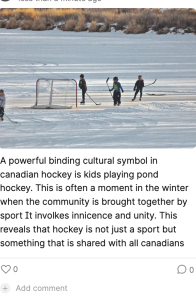4
These are difficult stories. We bear witness in this chapter to the role of sport in furthering the settler colonial projects throughout Turtle Island. Here are some supports to access in the community and from a distance:
First Peoples House of Learning Cultural Support & Counselling
Niijkiwendidaa Anishnaabekwag Services Circle (Counselling & Healing Services for Indigenous Women & their Families) – 1-800-663-2696
Nogojiwanong Friendship Centre (705) 775-0387
Peterborough Community Counselling Resource Centre: (705) 742-4258
Hope for Wellness – Indigenous help line (online chat also available) – 1-855-242-3310
LGBT Youthline: askus@youthline.ca or text (647)694-4275
National Indian Residential School Crisis Line – 1-866-925-4419
Talk4Healing (a culturally-grounded helpline for Indigenous women):1-855-5544-HEAL
Section One: History
A) The Residential School System
Exercise 1: Notebook Prompt
We are asked to honour these stories with open hearts and open minds.
Which part of the chapter stood out to you? What were your feelings as you read it? (50 words)
| One part of the chapter that really stood out to me was how there is this idea that sports are not healing or neutral, but an essential element of cultural genocide. Reading that made me so incredibly sad. Now sports are seemingly positive but they were once weaponized to erase culture, language and the indentities of indigenous children in residential schools.
|
B) Keywords
Exercise 2: Notebook Prompt
Briefly define (point form is fine) one of the keywords in the padlet (may be one that you added yourself).
the point im defining is cultural assimilation
|
C) Settler Colonialism
Exercise 3: Complete the Activities
Exercise 4: Notebook Prompt
Although we have discussed in this module how the colonial project sought to suppress Indigenous cultures, it is important to note that it also appropriates and adapts Indigenous cultures and “body movement practices” (75) as part of a larger endeavour to “make settlers Indigenous” (75).
What does this look like? (write 2 or 3 sentences)
| To me what this would look like is settlers adopting and making changed to indigenous traditions and practices. This could be seen in dance, sports, and potentially ceremonies, settlers taking these practices and removing the cultural, spiritual and traditional meanings to meet settlers ideologies. This was a way to feel like they belonged while removing the meaning from the people it was meaningful to and blending appropriation with domination and trying to over rule the indigenous people.
|
D) The Colonial Archive
Exercise 5: Complete the Activities
Section Two: Reconciliation
A) Reconciliation?
Exercise 6: Activity and Notebook Prompt
Visit the story called “The Skate” for an in-depth exploration of sport in the residential school system. At the bottom of the page you will see four questions to which you may respond by tweet, facebook message, or email:
How much freedom did you have to play as a child?
What values do we learn from different sports and games?
When residential staff took photos, what impression did they try to create?
Answer one of these questions (drawing on what you have learned in section one of this module or prior reading) and record it in your Notebook.
| Answering question 3: When residential staff took photos, what impression did they try to create? I believe that when the staff took the photos of the indigenous children at residential schools they tried to make them seem happy, healthy and like they were thriving in the environment provided to them. The photos of children playing settlers sports was used as propaganda (McKee & Forsyth, 2023), this was in the aim to mask the abuse and neglect that the children were enduring. The images presented were hiding the truth, hiding the bruises, hiding the mental exhaustion and emotional confusion. McKee, T., & Forsyth, J. (2023). Witnessing painful pasts: Understanding images of sports at Canadian Indian residential schools. In C. O’Bonsawin & J. Forsyth (Eds.), Decolonizing sport (pp. 48–65). Fernwood Publishing. |
B) Redefining Sport
B) Sport as Medicine
Exercise 7: Notebook Prompt
Make note of the many ways sport is considered medicine by the people interviewed in this video.
| Some of the ways that sports were considered medicine in the interview was through
1. emotional and spiritual healing. Sports were used as stress relief and a way to decompress from lifes battles. Chief Robert Joseph reflected on the trauma from the residential school and that sports can be used as a therapy to heal the deep pain. 2. Survival and connection to identity, lacrosse is veiwed as a gift from the creator. this is a sacred view that links sport to indigenous culture and tradition and often there was language and sport intertwined. playing sports while speaking traditional languages shows a sense of pride, strength and resistance in residential schools. 3. Intergenerational strength and legacy 4. Therapeutic release and mental well-being 5. pride, belonging, empowerment 6. Pathway to opportunity and reconciliation
|
C) Sport For development
Exercise 8: Notebook Prompt
What does Waneek Horn-Miller mean when she says that the government is “trying but still approaching Indigenous sport development in a very colonial way”?
| I think that what Waneek means is that while there are efforts being made, the approach still reflects colonial attitudes and power dynamics. while the intention is to try and aid indigenous peoples the approach is still not appropriate for what is truly needed. Instead of empowering Indiengous communities providing necessary funding, support and using systems based on their traditional ways, there is still a top down approach being used, funding structures, and using a westernized mindset and models of sport. |
Exercise 9: Padlet Prompt
Add an image or brief comment reflecting some of “binding cultural symbols that constitute Canadian hockey discourse in Canada.” Record your responses in your Notebook as well.

|
Section Three: Decolonization
Please see the major assignment for this half of the term in the final section of this chapter.

